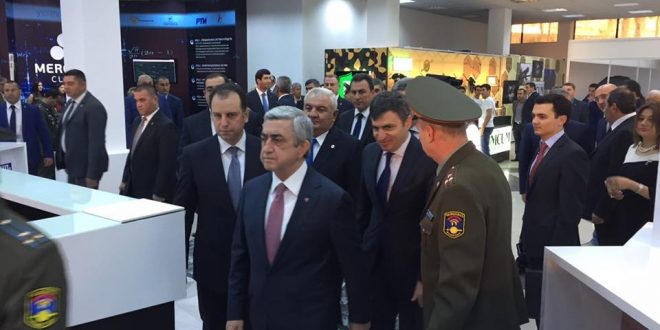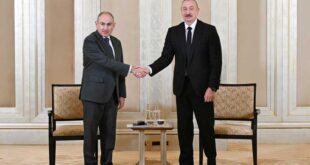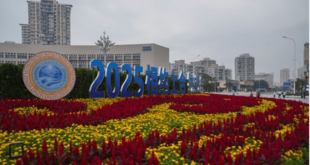In view of the enhanced NATO’s activity to expand its military presence on the Eastern European block, Russia embarks on the strategy of increasing its military buildup in the South Caucasus with the key air defense units to be deployed on the Armenian soil – Russia’s ally in Collective Security Treaty Organization (CSTO) that has chaired the recent CSTO assembly in Yerevan on October 14-16.
Prior to the CSTO meeting, in June 2016 the Armenian parliament ratified an agreement between Moscow and Yerevan on the establishment of a joint air defense system in the Caucasus region, and on October 07 Russian President Vladimir Putin passed the agreement to the Russian State Duma for approval.
The agreement constitutes establishment of the united air defense system based on the hierarchic principles of subordination of Armenian air defense assets to the strategic operational command of Russian Southern Military District Aerospace Forces. Should any potential threat arise, which, under the New Russian Military Doctrine, can be interpreted as such in case of any NATO’s activity in Eastern Europe, as well as applied to any NATO’s partnership programs with post-Soviet states, the command over the integrated joint air defense in the Caucasus shall be vested with the Russian Airspace Supreme Commander
As Armenian Defense Minister Seyran Ohanyan stated to the public TV Station Armenia 1, the agreement will stipulate usage of Russian fourth-generation multi-role jet fighters, S-300 systems, their anti-missile and radar capabilities for aerial reconnaissance when carrying regional air defense tasks.
Armenia has hosted Russia’s 102nd Military Base in Gyumri, since the mid 1990-ies, when the Soviet Union fell apart and Russia retained part of the military control over security in the region. Over the years, Russia supplied the Armenian base with defense arsenal. The base is now equipped with S-300V missile system as well as the relevant aircraft detection, tracking and missile guidance radars. Other military arsenal such as tanks, motors,-rifles and artillery units are also based there.
As preliminary accord on entering into a joint air defense system was reached between Armenia and Russia in December 2015, it opened up a way for Armenia to receive bigger quantities of Russian weapons to upgrade its air defense arsenal.
It is also noteworthy that In June 2015, the Russian government provided Yerevan with a $200 million loan to be spent on the purchase of Russian-made advanced weapons for Armenia’s armed forces through the year 2017, as a number of media sources reported.
Appearance of Russian-made Iskander mobile short-range ballistic missile launchers (NATO reporting name SS-26 Stone), on the streets of Yerevan during rehearsal of Armenia Independence Day Parade on September 21, suggested that the Iskander shipment could be a part of the loan, although the spokesperson for the Armenian Ministry of Defense dodged answering the question directly. Some media sources suggested that the Iskander in question was Iskander-M type, with a range of 500 kilometers.
There are already three MiG-29 squadrons deployed in the Armenian air base, which are capable of intercepting enemy aircraft and coupled with surface-to-air missile units, can serve as an effective air defense in the region.
According to the information shared with the Russian press, the Russian units will support Yerevan’s own substantial air defense capabilities. The units will include “Soviet-made SAM systems such as the S-125 Neva with a range of up to 12 miles, the Krug with a range of 27 miles, the newer and more modern S-300PS surface-to-air missile systems with a range of 93 miles, and the short-range missile systems Osa-AKM, Shilka, Strela-10, and Igla.”
The new joint air defense system is deemed to allow Moscow and Yerevan to access each other’s intelligence data on threats in the air.
So far, Russia and Armenia have not shared a common airspace, it is separated by Georgia.
“The joining together of their air defense systems will allow Moscow to create an additional ‘air defense umbrella’ beyond its borders,” pointed out the former deputy air defense commander of the Russian Ground Troops, Lt. Gen Alexander Luzan, in his comments to the Russian press.
Along with the CSTO Summit, Yerevan also for the first time hosted an international exhibition of arms and defense technologies ArmHiTech-2016 on October 13-15.
The exhibition was organized by the CSTO members’ interstate commission on the military and economic cooperation to demonstrate and to promote the structural reform of Armenia’s military industry backed by Russia.
Over the course of the CSTO Summit in Yerevan, the leaders of the states-members also adopted twenty-four documents, where part of the signed documents covered security aspects and development and creation of joint military training and standardization of military equipment. As per the signed documents, the framework of the CSTO will have its own center of crisis response that will provide analytical, organizational- and technical support to the CSTO solutions, as well as will facilitate the exchange of information in real time.
CSTO was established on the basis of the Treaty on Collective Security signed on 15 may 1992. The CSTO member countries include Armenia, Belarus, Kazakhstan, Kyrgyzstan, Russia and Tajikistan.
Ekaterina Pokrovskaya
 Geostrategic Media Political Commentary, Analysis, Security, Defense
Geostrategic Media Political Commentary, Analysis, Security, Defense





